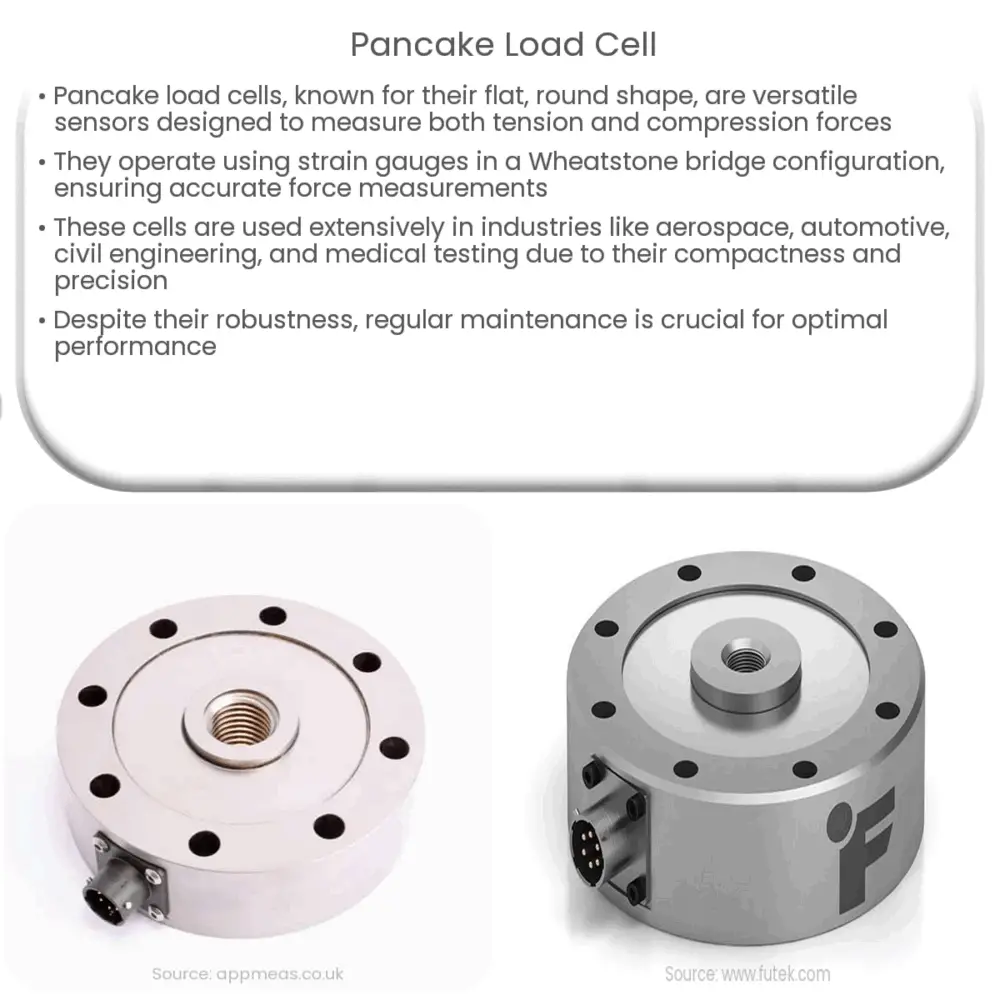Explore the mechanics, features, and diverse applications of pancake load cells in various industries, from aerospace to biomedical.

Pancake Load Cells: Understanding the Mechanics and Applications
Pancake load cells, also known as low-profile or universal load cells, are a unique type of force sensor designed for a variety of testing and measuring applications. They derive their name from their distinct flat, round shape reminiscent of a pancake. Unlike other load cells, they are specifically engineered to measure both tension and compression forces. This versatility, along with their robust design, makes pancake load cells highly sought after in numerous industries.
Working Principle
At the heart of every pancake load cell is the concept of strain gauges. Strain gauges are electrical conductors firmly attached to a film. When a force is applied to the film, the conductor’s length changes, resulting in a change in electrical resistance. This resistance change is proportional to the force applied, which is how the load cell measures force.
Pancake load cells utilize several strain gauges in a Wheatstone bridge configuration. This specific setup enhances the accuracy of force measurements by compensating for temperature changes, which may otherwise affect the strain gauges’ performance.
Construction and Features
-
The main body of a pancake load cell is typically made from high-strength stainless steel or alloy steel, ensuring durability and resistance to harsh environments.
-
These load cells often feature a threaded hole centrally located on each side. The upper hole allows the application of tensile forces, while the lower hole is for compression forces.
-
Pancake load cells can handle capacities from a few hundred pounds up to several hundred thousand pounds, showcasing their flexibility.
Applications of Pancake Load Cells
-
In Material Testing: Pancake load cells play a vital role in destructive and non-destructive material testing. They measure the tensile and compression strength of various materials, providing valuable data to engineers and researchers.
-
In Aerospace: These load cells are commonly used in the aerospace industry for force testing components and systems. They help ensure the safety and integrity of various aerospace parts, from landing gear to propulsion systems.
As we delve further into the world of pancake load cells, it becomes increasingly evident how these essential devices underpin many industrial processes. Their compact design, versatility, and high precision make them indispensable in a host of applications.
More Applications of Pancake Load Cells
-
In Automotive Manufacturing: Pancake load cells are integral to the automotive industry. They are used in numerous testing scenarios, such as crash tests, fatigue tests, and suspension component testing, ensuring the safety and performance of vehicles.
-
In Civil Engineering: The robust design of pancake load cells lends itself well to the construction industry. Engineers use them to test soil strength and the stability of structures, contributing to the safety and durability of infrastructure projects.
-
In Medical Field: In the biomedical field, pancake load cells are used in testing medical devices and equipment, ensuring these tools meet the stringent safety and performance standards.
Advantages of Pancake Load Cells
One of the key advantages of pancake load cells is their versatility. Their ability to measure both compression and tensile forces makes them suitable for a wide range of applications. Additionally, their low-profile design allows for easy installation in spaces where other types of load cells may not fit.
Pancake load cells are also known for their durability. Constructed from stainless steel or alloy steel, they can withstand harsh conditions, making them suitable for use in both indoor and outdoor environments.
Maintaining Pancake Load Cells
Despite their robustness, pancake load cells require regular maintenance to ensure accurate performance. This includes periodic calibration, cleaning, and checking for any signs of wear and tear. With proper maintenance, these devices can provide reliable service for many years.
Conclusion
In conclusion, pancake load cells are an essential tool in various industries. Their unique design allows them to measure both tensile and compression forces, making them incredibly versatile. Additionally, their compact and durable design means they can be used in a wide range of environments. While they require careful maintenance, their durability and versatility make them a valuable asset in many different applications. As technology continues to evolve, it’s likely that we’ll see even more innovative uses for pancake load cells in the future.



